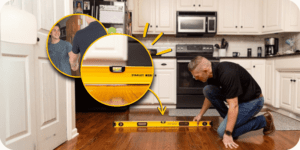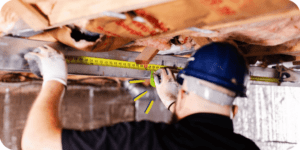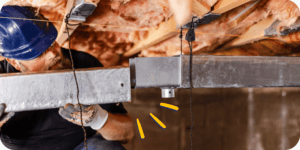Understanding and Fixing Sinking Floors
Have you noticed your floors sagging or uneven? “Floor sinking” is a common issue that many homeowners face. This problem can indicate serious underlying issues with your home’s foundation or structure. Let’s start understanding and fixing sinking floors, listing common issues like moisture, and tools like smart jacks. For a free estimate, contact our in-office customer care team and schedule a free inspection as a homeowner!
Causes of Floor Sinking
Foundation Issues:
- Firstly, one of the primary causes of floor sinking is problems with your foundation. Shifting soil, water damage, or poor construction can lead to a weakened foundation, causing your floors to sink.
Moisture Problems:
- Also, excess moisture in your crawl space or basement can cause wood beams and joists to rot and weaken. This leads to floors sagging over time.
Soil Settlement:
- Continually, the soil underneath your home can settle unevenly, especially if it was not properly compacted during construction. This uneven settlement can cause your floors to sink.
Pest Damage:
- Lastly, pests like termites can eat away at the wood supporting your floors, causing them to weaken and sink.

Signs of Floor Sinking
Uneven or Sagging Floors:
- Firstly, if you notice that your floors are uneven or sagging, it is a clear sign of floor sinking. Use a level to check if your floors are sloping.
Gaps Between Floor and Wall:
- Additionally, gaps between the floor and the baseboards or walls can indicate that your floor is sinking.
Cracks in Walls and Ceilings:
- Continually, cracks in your walls or ceilings, especially around doors and windows, can be a sign of foundation problems leading to the floor sinking.
Sticking Doors and Windows:
- Lastly, if your doors and windows are suddenly difficult to open or close, it could be due to your floors sinking and causing the frames to shift.

How to Fix Sinking Floors
Professional Inspection:
- Firstly, the initial step in fixing a sinking floor is to get a professional inspection. Experts can identify the root cause of the problem and recommend the best course of action. Luckily, TFS offers free inspections for homeowners!
Foundation Repair:
- Additionally, if foundation issues are causing your floors to sink, you may need foundation repair. Solutions can include underpinning, which involves adding support to your foundation, or using piers to stabilize it.
Moisture Control:
- Continually, controlling moisture levels in your crawl space or basement is crucial. Waterproofing, installing a sump pump, or using a dehumidifier can help prevent further damage.
Structural Repairs:
- Also, damaged or weakened beams and joists should be repaired or replaced to support your floors properly. This may involve adding new support beams or reinforcing existing ones.
Pest Control:
- Lastly, if pests are causing the problem, it is essential to address the infestation. Hire a pest control professional to eliminate the pests and repair any damage they have caused.

Preventing Floor Sinking
Regular Inspections:
- Most importantly, regularly inspect your home’s foundation, crawl space, and basement for signs of damage or moisture problems.
Maintain Proper Drainage:
- Additionally, ensure your gutters and downspouts direct water away from your foundation to prevent moisture buildup.
Control Humidity:
- Also, keep humidity levels low in your crawl space and basement to prevent wood rot and mold growth.
Address Issues Early:
- Last but not least, if you notice any signs of floor sinking, address them promptly to prevent further damage.

What Next?
Floor sinking is a serious issue that can indicate significant problems with your home’s foundation or structure. By understanding the causes, identifying the signs, and taking prompt action, you can protect your home from further damage. For professional help with floor sinking and other foundation issues, contact our in-office customer care team at TFS, The Foundation Specialists, here and schedule a free estimate for your home.
For regular tips and industry updates, follow us on Instagram and Facebook.

